
We will discuss the following aspects. Please scroll down and start reading.
- Introduction
- Oxygen Saturation
- Physical properties used in pulse oximetry
- Calibration
- Pulse oximeters measure pulsatile arterial blood
- The signal is tiny
- Plethysmographic trace (pleth)
- Light source
- Coping with ambient light
- Problems associated with using pulse oximeters.

Have you noticed that cats often look at things in mysterious ways? A writer has found out from cats how they secretly control the world! You can read all about it on the amusing website at the link below. It is entirely free.

Introduction
Pulse oximeters measure the percentage of haemoglobin in blood that is carrying oxygen (oxygen saturation).
If you work in healthcare (or have been a patient), you are likely to have come across pulse oximeters. You can find them in areas such as operating rooms, recovery rooms, critical care units, wards, and ambulances.
Pulse oximeters are in common use because they are:
- Non-invasive
- Cheap to buy and use
- Can be very compact
- Detects hypoxaemia earlier than you can visually detect cyanosis.
Oxygen Saturation
Pulse oximeters measure oxygen saturation. Before we learn about the principles of how pulse oximeters work, we need to understand what oxygen saturation is. We all know that we need oxygen for life. ( By the way, some of you may find this section a little too basic. In that case, to skip this short section, click here )

Oxygen enters the lungs and then is passed on into the blood. The blood carries oxygen to the various organs in our body. The primary way oxygen is carried in our blood is through haemoglobin. You can imagine haemoglobin molecules( Hb) as “cars” and the “roads” being our blood vessels. The oxygen molecules enter these cars and travel around the body until they reach their destination.

Let us consider these “haemoglobin cars”.
The haemoglobin without oxygen we will call de-oxygenated haemoglobin (deoxy Hb). The haemoglobin with oxygen, we will call oxygenated haemoglobin (oxy Hb).

Oxygen saturation simply refers to the percentage of the available haemoglobin that carries oxygen. Take the situations below. There are 16 haemoglobin units, and none of the 16 have oxygen. The oxygen saturation is therefore 0 %.

Here, 8 of the 16 Hb have oxygen. The oxygen saturation is therefore 50 %.

Similarly for 75 % …
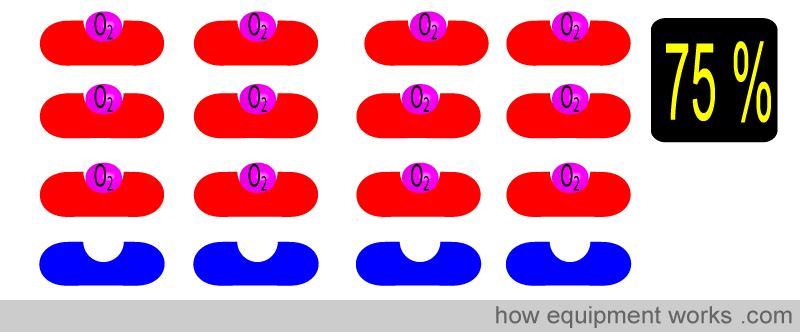
And of course, when all the Hb have oxygen, the saturation is 100 %

So, in summary, oxygen saturation tells you the percentage of the total haemoglobin that is carrying oxygen.
Physical properties used in pulse oximetry
Pulse oximetry uses light to work out oxygen saturation. Light is emitted from light sources, which goes across the pulse oximeter probe and reaches the light detector.

If a finger is placed between the light source and the light detector, the light must now pass through the finger to reach the detector. The finger will absorb part of the light, and the part not absorbed reaches the light detector.

The amount of light absorbed by the finger depends on several physical properties, which the pulse oximeter uses to calculate oxygen saturation.
The amount of light absorbed depends on the following:
1. Concentration of the light-absorbing substance.
2. Length of the light path in the absorbing substance
3. Oxyhemoglobin and deoxyhemoglobin absorb red and infrared light differently
Don’t worry! All the above will be explained in the next sections:
The physical properties that a pulse oximeter employs will be explained using the probe shown below. A finger is shown inserted into the probe. Above the finger are the light sources that emit light. In the finger is an artery which carries the blood the pulse oximeter is interested in, and a vein through which the blood leaves the finger. Below the finger is the light detector.

Physical property No.1: The amount of light absorbed is proportional to the concentration of the light-absorbing substance
Haemoglobin (Hb) absorbs light. The amount of light absorbed is proportional to the concentration of Hb in the blood vessel. In the diagram below, the blood vessels in both fingers have the same diameter. However, one blood vessel has a low Hb concentration (i.e., a low number of Hb in each unit volume of blood), and the other blood vessel has a high Hb concentration (i.e., a high number of Hb in each unit volume of blood). Each single Hb absorbs some of the light, so the more the Hb per unit area, the more light is absorbed. This property is described in a law in physics called “Beer’s Law”.
Beer’s Law: The amount of light absorbed is proportional to the concentration of the light-absorbing substance
By measuring the amount of light reaching the light detector, the pulse oximeter determines how much light has been absorbed. The more the Hb in the finger, the more light is absorbed.

Physical property No.2: The amount of light absorbed is proportional to the length of the light path.
Look at the two fingers shown below. Both arteries have the same concentration (same Hb per unit area, indicated by the blue square). However, the artery on the right is wider than the one on the left.

The light emitted from the source has to travel through the artery. The light travels a shorter path in the narrow artery and a longer path in the wider artery (paths are shown as green lines below). Although the concentration of Hb is the same in both arteries, the light encounters more Hb in the wider artery, as it travels a longer path. Therefore, the longer the path the light has to travel, the more light is absorbed. This property is described in a law in physics called “Lambert’s Law”.
Lambert’s Law: The amount of light absorbed is proportional to the length of the path that the light has to travel in the absorbing substance.

Physical property No.3: oxyhemoglobin absorbs more infrared light than red light & deoxyhemoglobin absorbs more red light than infrared light (this is explained below !)
We have seen how concentration and light path affect the absorbance of light. In addition to these, the pulse oximeter utilises another essential property to calculate oxygen saturation. That is, oxyhemoglobin and deoxyhemoglobin absorb light of different wavelengths in a specific way.
Before we proceed, let’s recall what a wavelength is. All light is composed of waves. The distance between the “tips” of the waves is equal to the wavelength.

Light wavelengths are very short, and the unit of measurement is in nanometers (nm) (1 meter = 1,000,000,000 nanometers). For example, the wave on the left has a wavelength of 650 nm, and the wave on the right has a longer wavelength of 950 nm.
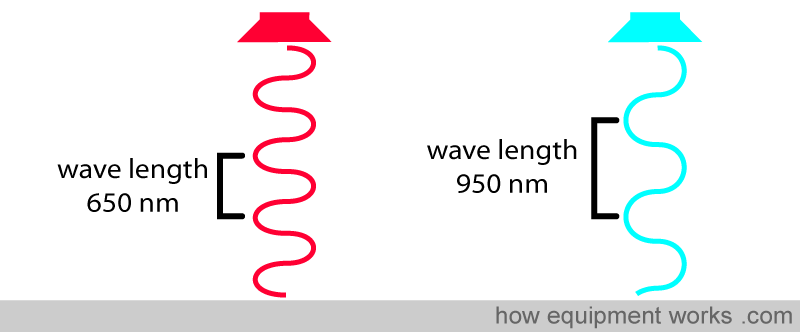
Different “colours” of light have different wavelengths.

The pulse oximeter uses the property that oxyhemoglobin and deoxyhemoglobin absorb light of different wavelengths in a specific way. This property can be demonstrated in a laboratory, as described below. We can first demonstrate how oxyhemoglobin absorbs light of different wavelengths in a particular way. We use a special light source from which we can adjust the wavelength of the light it emits. This light source sequentially passes light of different wavelengths through a sample of oxy Hb. The detector notes how much light, at each wavelength, has been absorbed.

A graph for the absorbance of oxyhemoglobin at different wavelengths will look like this. It shows that oxy Hb doesn’t absorb the same amount of light at different wavelengths.

We can repeat the same demonstration using deoxy Hb.

Again, notice how, like oxy Hb, Deoxy Hb absorbs different amounts of light at different wavelengths.

Now, let’s examine the absorbance graphs of oxy Hb and deoxy Hb together, allowing you to compare them. Note how each of them absorbs light of different wavelengths very differently.

The pulse oximeter uses two lights to analyse haemoglobin.

One is a red light, which has a wavelength of approximately 650 nm. The other is infrared light, which has a wavelength of 950 nm. Throughout our description, we will show the infrared light in light blue. In reality, infrared light is invisible to the human eye.

Now look at the oxy Hb absorbance graph again, but this time pay attention to the wavelengths of light used in pulse oximeters. You will see that oxy Hb absorbs more infrared light than red light.

Below is the graph showing the absorbance of deoxy Hb. It is seen from the graph that deoxy Hb absorbs more Red light than Infrared light.

To facilitate the comparison of the absorbance of oxy-Hb and deoxy-Hb, a composite graph is provided below, showing the absorbance of both. You will see that :
Oxy Hb absorbs more infrared light than red light
Deoxy Hb absorbs more red light than infrared light

You may find the memory aid below helpful in remembering the wavelengths absorbed by oxy Hb and deoxy Hb.

The pulse oximeter determines oxygen saturation by measuring the amount of red light and infrared light absorbed by the blood. Depending on the amounts of oxy Hb and deoxy Hb present, the ratio of the amount of red light absorbed compared to the amount of infrared light absorbed changes.

Using this ratio, the pulse oximeter can then work out the oxygen saturation.

For example, at 100% saturation, the absorbance ratio (i.e., comparing how much red light and infrared light are absorbed) will be the same as that seen with the oxy Hb absorbance curve that we saw earlier.

At 0 % saturation, there is only deoxy Hb. The absorbance ratio (i.e., comparing how much red light and infrared light are absorbed) will therefore be the same as that seen with the deoxy Hb absorbance curve that we saw earlier.

Now, consider the case where the patient has an oxygen saturation of 75%. The blood contains both oxy Hb and deoxy Hb. The absorbance pattern is now positioned somewhere between the oxy Hb curve and the deoxy Hb curve (both shown in grey). The ratio of absorbed red light and infrared light is different, and using this information, the pulse oximeter calculates the oxygen saturation as 75 %.

At 50% oxygen saturation, the absorbance pattern differs from when the saturation was 75%. The ratio of red light and infrared light absorbed is also therefore different, and the pulse oximeter uses this to calculate the saturation as 50%.

At 25 % saturation, you and your patient are in deep trouble. Again, the ratio is different.

The animation below shows what you have seen before. As the amount of oxy Hb and deoxy Hb changes, the light ratio comparing red and infrared light also changes. The pulse oximeter uses this ratio to calculate the oxygen saturation.
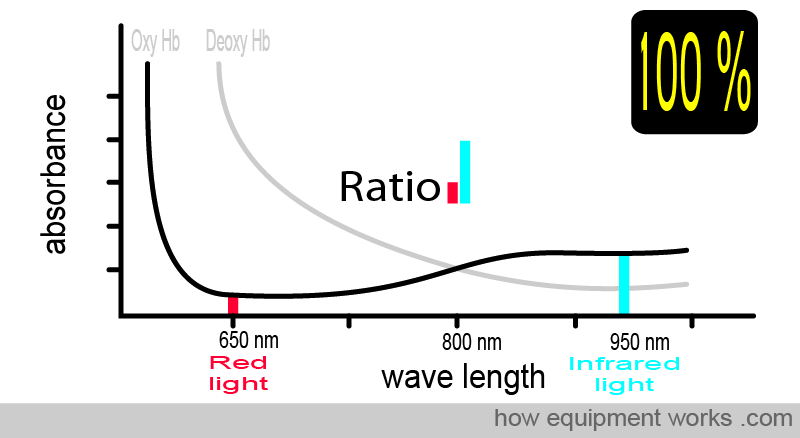
To summarise things so far, the absorbance of light depends on:
1. Concentration of the light-absorbing substance.
2. Length of the light path in the absorbing substance
3. Oxyhemoglobin and deoxyhemoglobin absorb red and infrared light differently
The pulse oximeter computer takes these factors and computes the saturation.


Hello! My name is Pras and I am the author of this website that you are now reading. I have made this website completely free to access so that people from all over the world can benefit from it.
If you can afford it, I would be very grateful if you would consider making a single donation of one dollar (or the equivalent in your currency) to help cover the expenses needed to run this website (e.g. for special software and computers). For this website to survive, donations are desperately needed. Sadly, without donations, this website may have to be closed down.
Unfortunately, perhaps because many people think that someone else will donate, this website gets only very few donations. If you are able to, please consider making a single donation equivalent to one dollar. With support from people like you, I am sure that this educational website will continue to survive and grow.



Have you noticed that cats often look at things in mysterious ways? A writer has found out from cats how they secretly control the world! You can read all about it on the amusing website at the link below. It is entirely free.

Calibration Adjustment
Early on, we discussed how the pulse oximeter utilises Beer’s and Lambert’s Law (absorbance depends on concentration and path length) as part of the factors it uses to compute oxygen saturation. Unfortunately, there is a problem. In physics, the Beer-Lambert law has stringent criteria for accuracy. For example, the light that passes through the sample should pass straight through, similar to the light rays in the image below.

However, in real life, this does not happen. Blood is not a neat red liquid. Instead, it is full of various irregular objects, such as red cells, etc. This causes the light to scatter, rather than travel in a straight line. Therefore, Beer-Lambert’s Law cannot be applied strictly.

Because Beer-Lambert’s law cannot be applied strictly, errors would occur if it were used to directly calculate oxygen saturation. A solution to this is to use a “calibration graph” to correct for errors. A test pulse oximeter is first calibrated using human volunteers. The test pulse oximeter is attached to the volunteer, and then the volunteer is asked to breathe lower and lower oxygen concentrations. At intervals, arterial blood samples are taken. As the volunteer’s blood desaturates, direct measurements made on the arterial blood are compared simultaneously with the readings shown by the test pulse oximeter. In this way, errors due to the inability to apply Beer-Lambert’s law strictly are noted, and a calibration graph is created. However, to prevent harm to the volunteers, the oxygen saturation is not allowed to drop below approximately 75-80%.

A copy of this correction calibration graph is available inside the pulse oximeters in clinical use. When doing its calculations, the computer refers to the calibration graph and corrects the final reading displayed. As mentioned before, the volunteer studies described earlier do not allow saturation to drop below about 75-80%. For saturations below this, the calibration curve is mathematically estimated. Therefore, pulse oximeters are typically less accurate below saturations of approximately 75-80%.

Pulse oximeters measure pulsatile blood
In a body part such as a finger, arterial blood is not the only thing that absorbs light. Skin and other tissues also absorb some light. This poses a problem because the pulse oximeter should only analyse arterial blood while ignoring the absorbance of light by surrounding tissues. For an example of how tissues can interfere, take the two situations shown below. One is a thin finger and the other is a fat finger. The tissues in the thin finger absorb only a little extra light, while the fatter finger shown on the right absorbs much more light. However, the pulse oximeter has no way to measure whether the finger is fat or thin. It therefore has the potential to be confused because it doesn’t know how much light is absorbed by blood and how much is absorbed by the surrounding tissues.

Fortunately, there is a clever solution to the problem. The pulse oximeter aims to analyse only arterial blood, disregarding the surrounding tissues. Luckily, arterial blood is the only thing pulsating in the finger. Everything else is non-pulsating. Any “changing absorbance” must therefore be due to arterial blood.

On the other hand, the pulse oximeter recognises that any absorbance that remains constant must be due to non-pulsatile factors, such as skin and other “non-arterial” tissues.

So the final signal picture reaching the pulse oximeter is a combination of the “changing absorbance” due to arterial blood and the “non-changing absorbance” due to other tissues.

The pulse oximeter utilises clever mathematics to extract the “changing absorbance” signal from the total signal, as described below. As shown below, the computer subtracts the non-changing part of the absorbance signal from the total signal. After subtraction, only the “changing absorbance signal” remains, which corresponds to the pulsatile arterial blood. In this way, the pulse oximeter can calculate the oxygen saturation in arterial blood while ignoring the effects of surrounding tissues.

The signal is really small!
The diagrams used so far have exaggerated the size of the pulsatile part to make it easy for you to see and understand.
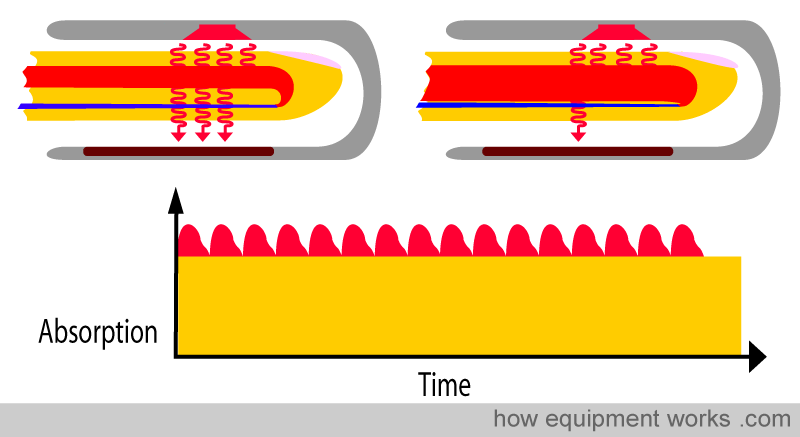
However, in reality, the pulsatile signal is very small. Typically, only about 2% of the total signal is pulsatile! Drawn to scale, 2% of the total signal will appear as shown in the diagram below. The orange part represents the “non-changing” light absorbed by the tissues. The red shows the changing absorbance due to pulsatile arterial blood. See how small this pulsatile signal is. Of all the light that passes through the finger, it is only the small pulsatile part that the pulse oximeter analyses. Because it represents such a small portion of the total light, the pulse oximeter is highly susceptible to errors if, for example, the probe is not placed properly or if the patient moves the probe.

Plethysmographic trace (Pleth)
Pulse oximeters often show the pulsatile change in absorbance in a graphical form. This is called the “plethysmographic trace ” or more conveniently, “pleth”.

The pleth is an extremely important graph to see. It tells you how good the pulsatile signal is. If the quality of the pulsatile signal is poor, the calculation of oxygen saturation may be inaccurate. The pulse oximeter employs complex calculations to determine oxygen saturation. A poor pleth tracing can easily fool the computer into wrongly calculating the oxygen saturation. As human beings, we tend to believe what is good, so when we see a high saturation level, such as 99%, we are more likely to accept it, even if the patient’s actual saturation may be much lower. Always look at the pleth first, before checking oxygen saturation.

Never look only at oxygen saturation!

To remind you (okay, I promise, this is the last time!), think of “SpO2” as a reminder …..

The pleth is affected by factors that affect the peripheral blood flow. For example, low blood pressure or peripheral cold temperature can reduce it.
Sophisticated uses of the pleth are being developed. For example, it may be used to guide fluid therapy. These discussions are beyond the scope of this website.
Light source
Pulse oximeters use a type of light source called “light emitting diodes” (LED), which are extremely commonly used in electronics.

Light-emitting diodes are ideal for pulse oximeters because :
- They are cheap ( so can be used even in disposable probes)
- They are very compact (can fit into very small probes)
- They emit light in accurate wavelengths
- They do not heat up much during use (low temperature makes it less likely to cause patient burns)
Light-emitting diodes come in a variety of types that emit light at specific wavelengths. Fortunately, there are light-emitting diodes (LEDs) that emit light in the red and infrared light wavelengths, and these are thus conveniently used in pulse oximeters. The exact wavelengths of the LEDs used depend on the manufacturer. For convenience, in our discussions, we assigned the red LED a wavelength of 650 nm and the infrared LED a wavelength of 950 nm (easy to remember). However, most textbooks will quote 660 nm and 940 nm.
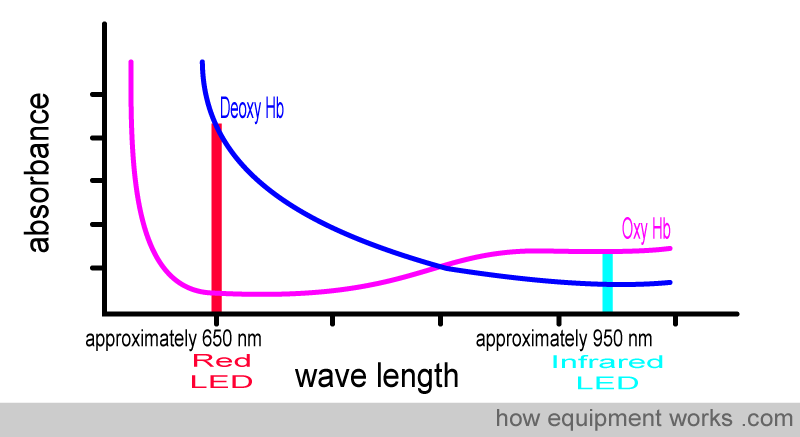
Accounting for ambient (room) light
The pulse oximeter probe, as shown below, has a red LED and one infrared LED. On the other side is a light detector. However, you will note that, though there are only two LEDs, the light detector is exposed to three sources of light. In addition to the red and infrared LED light sources, there is also light in the room (ambient light) that the pulse oximeter is working in. Some of the light from this room can also reach the detector. The pulse oximeter has to work with these three sources of light. It wants the red and infrared light to calculate oxygen saturation. On the other hand, the room light is unwanted “noise” and needs to be taken into account. The process by which this is done will be explained.
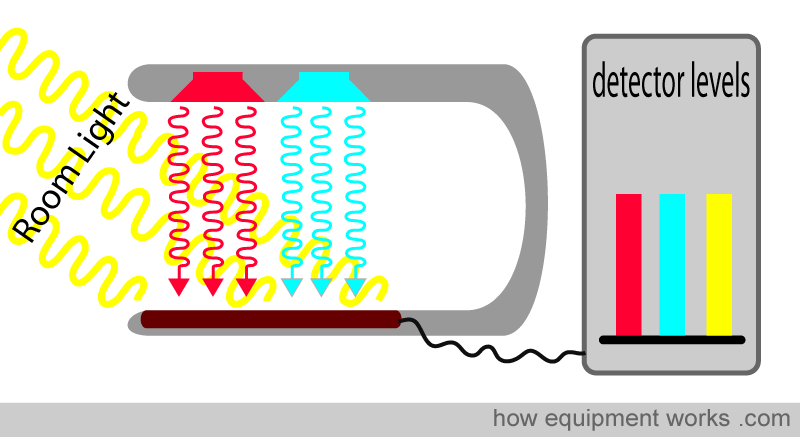
The above diagram illustrates both LEDs lit to facilitate the explanation. In reality, both LEDs are never lit together. Instead, the pulse oximeter rapidly switches the LEDs on and off in a particular sequence. First, the pulse oximeter activates the red LED light. The red light goes through the finger (not shown, to make the image less crowded) and reaches the detector. Stray room light also reaches the detector. The detector, therefore, records red light and room light that falls on it.

Next, the pulse oximeter switches off the red LED light and switches on the infrared LED light. The infrared light goes through the finger (not shown) and reaches the detector. Stray room light also reaches the detector. The detector therefore records infrared light and room light that falls on it.
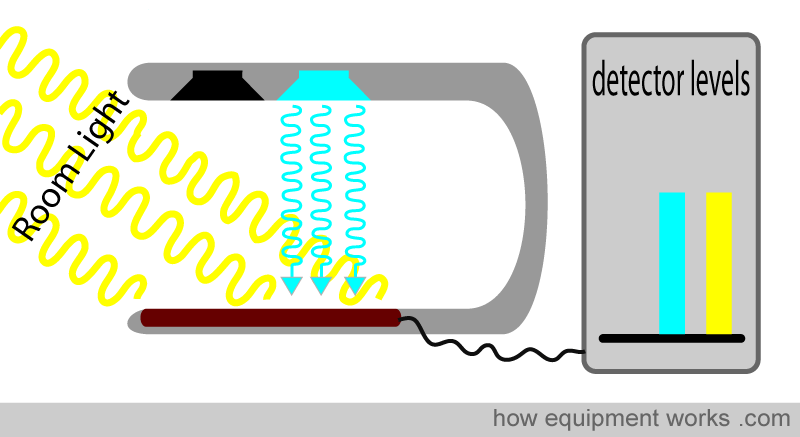
Finally, the pulse oximeter switches off both the red and infrared LED lights. Now, the only light that falls on the detector is the room light. The pulse oximeter now records the room light level.

Because the pulse oximeter now knows the level of room light, it can subtract it from the readings to get the actual red and infrared light levels.

The animation below shows the LEDs switching on and off in sequence. The animation is shown in slow motion to make it easy to understand. In reality, this switching happens hundreds of times per second.
So here is the sequence:
Only the red LED is on. The sensor measures the red light plus the room light.
Only the infrared LED is on. The sensor measures the infrared light plus the room light.
Both LEDs are off. The sensor measures only the room light.
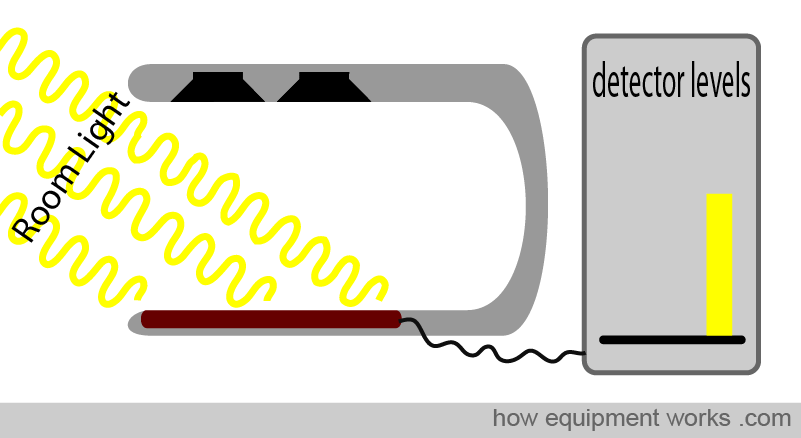
Problems with the pulse oximeter
Problem of movement
When considering problems associated with pulse oximeters, it is essential to remember that the signal being analysed is tiny. As explained before, it is only about 2 % of the total light that is analysed.
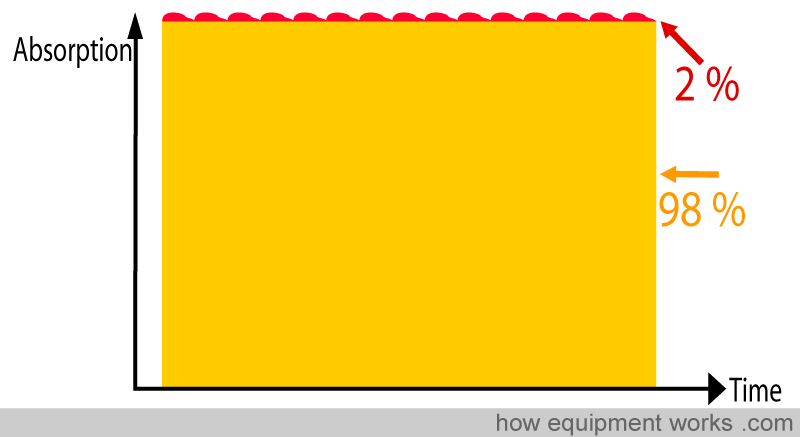
With such a small signal, it is easy to see how errors can occur. Pulse oximeters are highly susceptible to motion, such as a patient moving their hand. As the finger moves, the light levels change dramatically. Such a poor signal makes it difficult for the pulse oximeter to calculate oxygen saturation.

The problem of optical shunting
The pulse oximeter operates most effectively when all the light passes through arterial blood, as illustrated by the upper finger in the image below. However, if the probe is of the wrong size or has not been appropriately applied, some of the light, instead of going through the artery, goes by the side of the artery (shunting)(lower finger in the image below). This reduces the strength of the pulsatile signal, making the pulse oximeter prone to errors. It is therefore essential to select the correctly sized probe and to position the finger correctly within the chosen probe for optimal results.

The problem of too much ambient light
As discussed before, in addition to the light from the LEDs, ambient (room) light also hits the detector. For the pulse oximeter to function correctly, the strength of the LED light falling on the detector should be good when compared to the strength of the ambient light falling on the detector.

If the ambient light is too strong, the LED light signal gets “submerged” in the noise of the ambient light. This can lead to erroneous readings.

Therefore, it is important to minimise the amount of ambient light falling on the detector. One can try to move the probe away from strong sources of room light. One can also try to cover the pulse oximeter probe and finger with a cloth, etc.

The problem of electromagnetic interference
Electrical equipment such as surgical diathermy emits strong electric waves, which the wires of the pulse oximeter may pick up. These waves (shown in green below) cause small currents to form in the wires, confusing the pulse oximeter, which assumes these currents originate from the light detector. When using diathermy, one should exercise caution when interpreting pulse oximeter readings.

The problem of poor peripheral perfusion
Good peripheral blood flow makes the arteries in the fingers appear nicely pulsatile. As previously discussed, it is the pulsatile change in absorbance that is used in calculating oxygen saturation.
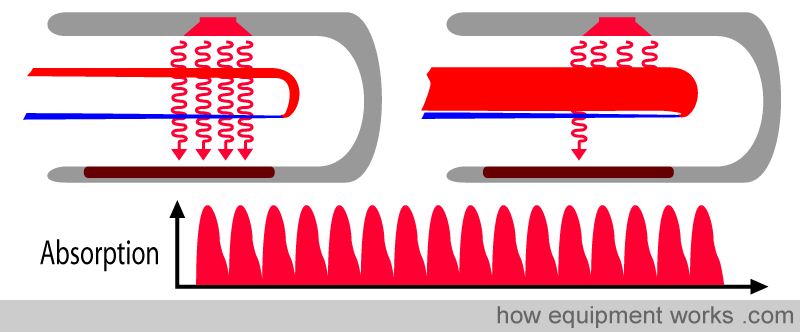
When peripheral perfusion is poor (e.g., in hypotension), the arteries are significantly less pulsatile. The change in absorbance is therefore less, and the pulse oximeter may then find the signal inadequate to correctly calculate oxygen saturation.

The problem of not detecting hyperoxia
Initially, we discussed that oxygen saturation refers to the percentage of haemoglobin that is carrying oxygen. In the example below, all the haemoglobin is carrying oxygen, and therefore the oxygen saturation is 100 %.
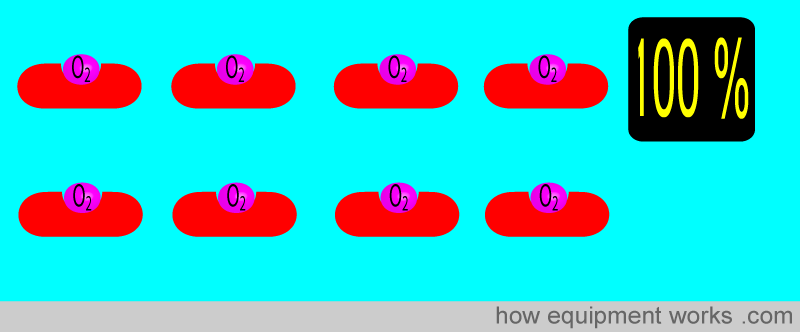
However, haemoglobin is not the only way oxygen is carried in the blood. Additional oxygen can also be dissolved in the solution in which red blood cells travel (plasma). The problem is that the pulse oximeter cannot “see” the extra dissolved oxygen. So, even though this patient’s blood is full of extra oxygen, the saturation still shows 100%, instead of, say, 120%.

The 100 % saturation in the above example tells us that the patient is getting enough oxygen. However, it does not indicate that the patient is receiving too much oxygen (hyperoxia). Oxygen, while necessary for life, can be harmful if given in excess. Therefore, other means (e.g. arterial blood gas) have to be used to detect hyperoxia.
Problem of calibration
As mentioned earlier, pulse oximeters are calibrated using human subjects. This means that low saturations may not be accurate.

Problem of Colored dyes and nail polish
The dye, methylene blue, if in the patient’s circulation, will artificially lower the displayed oxygen saturation. Fingernail polish can affect the accuracy of saturation determination.

Problem of abnormal haemoglobins
Abnormal haemoglobin can affect pulse oximeter readings. Carbon monoxide combines with haemoglobin to form carboxyhaemoglobin. Most pulse oximeters cannot separately detect carboxyhaemoglobin. Instead, it considers carboxyhemoglobin as oxyhemoglobin. This is dangerous because carboxyhemoglobin doesn’t carry oxygen, and the artificially high oxygen saturation displayed may wrongly reassure everyone. Another abnormal haemoglobin, called methemoglobin, causes the saturation to falsely show readings towards about 85 %

We have now reached the end of our discussion on pulse oximetry. I hope it has provided you with a good introduction to the subject and will be helpful as you read further on this topic. This website is primarily funded by donations, so if you can help, please consider making a small contribution as described below. Additionally, I don’t have an advertising budget, so please share this website with your colleagues, near and far. Thank you very much.

Hello! My name is Pras and I am the author of this website that you are now reading. I have made this website completely free to access so that people from all over the world can benefit from it.
If you can afford it, I would be very grateful if you would consider making a single donation of one dollar (or the equivalent in your currency) to help cover the expenses needed to run this website (e.g. for special software and computers). For this website to survive, donations are desperately needed. Sadly, without donations, this website may have to be closed down.
Unfortunately, perhaps because many people think that someone else will donate, this website gets only very few donations. If you are able to, please consider making a single donation equivalent to one dollar. With support from people like you, I am sure that this educational website will continue to survive and grow.

